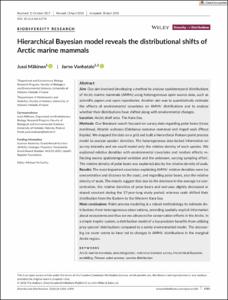Hierarchical Bayesian model reveals the distributional shifts of Arctic marine mammals.

View/
Average rating
votes
Date
2018Author
Makinen, Jussi
Vanhatalo, Jarno
Metadata
Show full item recordAbstract
Our aim involved developing a method to analyse spatiotemporal distributions of Arctic marine mammals (AMMs) using heterogeneous open source data, such as scientific papers and open repositories. Another aim was to quantitatively estimate the effects of environmental covariates on AMMs' distributions and to analyse whether their distributions have shifted along with environmental changes. Location: Arctic shelf area. The Kara Sea. Methods: Our literature search focused on survey data regarding polar bears (Ursus maritimus), Atlantic walruses (Odobenus rosmarus rosmarus) and ringed seals (Phoca hispida). We mapped the data on a grid and built a hierarchical Poisson point process model to analyse species' densities. The heterogeneous data lacked information on survey intensity and we could model only the relative density of each species. We explained relative densities with environmental covariates and random effects reflecting excess spatiotemporal variation and the unknown, varying sam.....
Journal
Diversity And DistributionsVolume
24Issue
Article 12776Page Range
pp.1381-1394Document Language
enSustainable Development Goals (SDG)
14.2Spatial Coverage
Kara SeaDOI Original
http://dx.doi.org/10.1111/ddi.12776Citation
Mäkinen, J. and Vanhatalo, J. (2018) Hierarchical Bayesian model reveals the distributional shifts of Arctic marine mammals. Diversity and Distributions, 24:12776, pp.1381–1394. DOI: https://doi.org/10.1111/ddi.12776Collections
- CAPARDUS Practices [147]
The following license files are associated with this item:
 Repository of community practices in Ocean Research, Applications and Data/Information Management
Repository of community practices in Ocean Research, Applications and Data/Information Management
